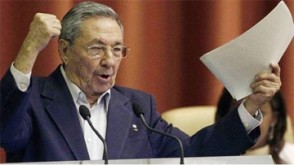By Norman Girvan and Alissa Trotz
Alissa Trotz is editor of the Diaspora column. Norman Girvan is Professorial Research Fellow at the UWI Graduate Institute of International Relations at the University of the West Indies in St. Augustine, Trinidad and Tobago.
Cuba’s proposed economic reforms have attracted much attention, the focus falling on plans to redeploy up to one million employees from state sector to self-employment and small business. The comments mostly reflect a particular ideological perspective or interpret the policy changes through the lens of neoliberal adjustment programmes of the kind familiar to us in the Caricom Caribbean. The proposals, which are contained in 291 points in the Draft Economic and Social Policy Guidelines released in November, need to be considered in their totality and set in context.
Two weeks ago (on December 7) we had the opportunity to discuss them with leading Cuban economists of the Cuban National Association of Economists (ANEC), from the Spanish acronym) involved in their preparation and dissemination. The opportunity arose during a conference on the Caribbean at the University of Havana, held each year to coincide with Cuba-Caricom Day. Along with other colleagues from the Institute of International Relations at the University of the West Indies, we talked late into the night with our Cuban hosts about the Draft Guidelines, the domestic and international context that framed them, and their hopes for Cuba’s future. We are still trying to process our impressions—a kind of outsider’s inside view—but wish to share some of them in this column.

Second, we were struck by the candour with which the Cubans discussed the internal factors responsible for poor economic performance. The Guidelines note the combined effects of the US blockade (over US$100 billion cost to the Cuban economy since 1962), a 15% fall in the purchasing power of exports over 1997-2009, the international economic crisis and global climate change (including 16 hurricanes costing US$20.6 billion over 1998-2008). But they do not place all the blame on these external shocks. Low productive efficiency and decapitalisation of the productive base and infrastructure are identified as the main constraints on growth; and the current model of economic management is seen as the culprit. They also confront the need to strike a new development path in a rapidly changing international environment. The rationing system is one example of inefficiency mentioned, in that the principle of egalitarian and subsidized distribution stimulated a black market that benefited those who did not need it, who could exchange or resell the products.
Third, while commitment to the socialist system is retained; the socialist model practiced in Cuba is to be changed insofar as macro and enterprise-level economic
management is concerned. What emerges is a uniquely engineered Cuban hybrid. It will combine several forms of social property and guarantees of universal social services, with features of a market system that provide material incentives for individual productivity and enterprise efficiency. Importantly, the Guidelines state that ‘socialism is equality of rights and opportunities for the citizens, not egalitarianism…work..must be remunerated according to its quantity and quality’ (Economic and Social Policy Guidelines, para.2, our emphasis). Indeed, to mitigate the expected increase in income inequalities, a progressive income tax is to be introduced.

The forms of social property are now to include (a) budgeted entities, which provide public and social services and will be financed directly by the state, (b) enterprises producing marketed goods and services, (c) cooperatives, and (d) a non-state sector. The intention is to take enterprises and cooperatives off the government budget. They will be expected to pay their own way; if they don’t, they will be closed down. On the other hand, they will be permitted to retain a portion of whatever profits they make, using them for reinvestment or for employee benefits; to decide on the number of employees they hire; and to determine their prices, albeit within limits. The changes in the economic management model (1-24) indicate a major departure from the centralized system of the past and are aimed at promoting efficiency, higher productivity and innovation. Yet the changes in regulations will need to be accompanied by revolutionary changes in attitudes, practices and behaviours among enterprise management and employees. The Guidelines hint at this, but appear to place reliance on strengthening systems of internal control—which will hardly be enough.
Some 178 activities have been approved for personal investment and own-account activity in the non-state sector. Existing laws are to be reviewed to determine the changes needed to effect redeployment from the state sector, as well as to ensure that existing social protections are extended equally and without exemption to the non-state sector. This includes one year maternity leaves, pensions and sick leaves. What we were unable to determine were the criteria and the procedures used to identify the number of excess state sector employees to be redeployed. Nonetheless, we formed the impression that the proposal is to move from a system of guaranteed employment to one of efficient employment. How this will work out, in terms of the possible emergence of open unemployment, remains to be seen.
The Guidelines prioritise export diversification into higher-value goods and services; and the need to reduce the huge food import bill—objectives with considerable resonance in the Caricom Caribbean. To achieve these, there will be encouragement of local and foreign private investment and of small-scale and cooperative farming. The challenges here will be reconciling these goals with the demands of international markets while maintaining socialist principles and practice. While the Cuban work force is highly educated, Cuban laws guarantee a high degree of social protection for employees, and officials are known to drive tough bargains with foreign investors. Competition for foreign investment among emerging economies is fierce. The solution may lie in further development of national export industries, and joint ventures with foreign partners; by exploiting Cuban technological prowess in biotechnology, pharmaceuticals and other medical products; and in health, sports and cultural tourism. All of these are mentioned in the Guidelines.
Revisions are to be made to the fiscal regime to incentivize agricultural production. Cuba is a net importer of food, yet 50% of state-owned farmland is unproductive. The question arises whether the desired expansion can happen without a major shift towards private farming and higher prices for domestic food; sufficient to attract significant numbers of urban dwellers into farming. These could mean the emergence of a relatively wealthy farming class; and/or a fall in urban living standards—neither of which may be politically acceptable. Unsurprisingly, they do not appear in the Guidelines.
Our conclusion, based on the open exchanges with ANEC officials and a quick review of the Guidelines, is that they amount both to a ‘paradigm shift’ and ‘a work in progress’. More than anything else, this is evident from the huge effort going into the process of nationwide consultation and preparation. The 291 Guidelines are being studied and debated, point by point, by the National Assembly of People’s Power. Starting in November, they are also being discussed at all layers of the Cuban economy and society—in hotels, factories, other enterprises and ministries; in the provinces and municipalities; and in the mass organisations for workers, women and youth as well as in the Communist Party organs. The 80,000 strong National Association of Cuban Economists (ANEC) has been tasked with the responsibility to train 400 cadres from the Cuban Communist Party to explain the changes in non-technical language at these meetings; where “each of the 291 points will be accepted, modified or deleted”. Then they have the job of synthesising the results into a revised document for the VI Communist Party Congress slated for the end of March. “There is no other country in the world”, says ANEC President Roberto Verrier Castro, “where a new policy like this is discussed at all layers of society before it is adopted.”
We could not help a comparison with the practice in the Caribbean and the countries of liberal democratic capitalist heartlands, where decisions are negotiated behind closed doors with international financial institutions and the interests they represent, and announced as fait accompli. Back at our hotel after our meeting, we turned on the television to reports of the massive student protests on the streets of London against drastic cuts to higher education and steep increases in tuition fees. In the United States, President Obama was backpedalling on his earlier commitment not to extend the blatantly iniquitous Bush-era tax cuts to the rich. And Cuba, with arguably the most advanced system of education and health care in Latin America and the Caribbean and with a record of international solidarity that is second to none, continues to be subjected to an illegal and inhumane half century old blockade from the mightiest power on the planet.
It seems to us that ideologically-slanted debates over the nature of the reforms miss the point. Cuba is entering uncharted territory, for which there is no existing ‘best-practice’ model. It will be one of the sternest tests yet of the Cuban capacity at problem-solving and of managing change to place the economy on a growth path while softening the impact on living standards and preserving the essence of its socialist system. On December 18 President Raul Castro told the National Assembly that the reforms were critical to consolidation of Cuban socialism: “We can either rectify the situation, or we will run out of time walking on the edge of the abyss, and we will sink.” We wondered whether the five year time-frame that was mentioned to us by our Cuban friends will be sufficient to work out all the kinks and get the new model up and running.
It will be a moving target, for Cuba like the rest of the Caribbean, is highly vulnerable to changes in the global scene. But the Cuban people’s resilience and determination to survive, having battled against seemingly overwhelming odds for 52 years, have to be seen ‘from the inside’ to be really understood.
http://www.walterlippmann.com/pcc-draft-economic-and-social-policy-guidelines-2010.html
